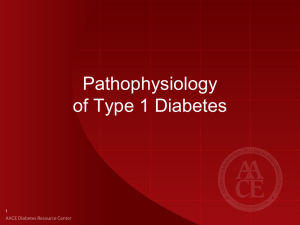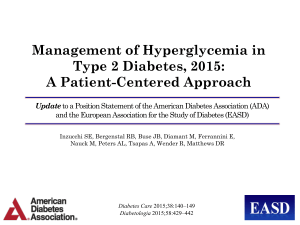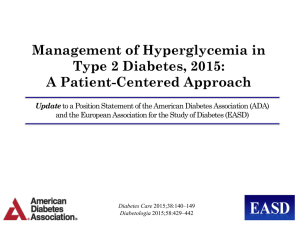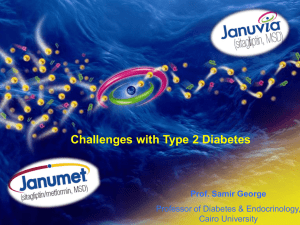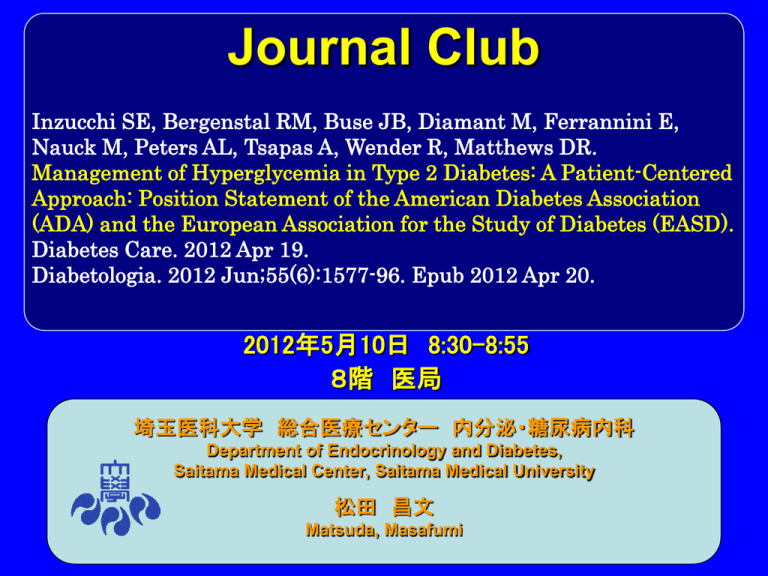
Journal Club
Inzucchi SE, Bergenstal RM, Buse JB, Diamant M, Ferrannini E,
Nauck M, Peters AL, Tsapas A, Wender R, Matthews DR.
Management of Hyperglycemia in Type 2 Diabetes: A Patient-Centered
Approach: Position Statement of the American Diabetes Association
(ADA) and the European Association for the Study of Diabetes (EASD).
Diabetes Care. 2012 Apr 19.
Diabetologia. 2012 Jun;55(6):1577-96. Epub 2012 Apr 20.
2012年5月10日 8:30-8:55
8階 医局
埼玉医科大学 総合医療センター 内分泌・糖尿病内科
Department of Endocrinology and Diabetes,
Saitama Medical Center, Saitama Medical University
松田 昌文
Matsuda, Masafumi
21世紀の生活習慣病のマルチケア
心血管イベント リスク
高脂血症
(脂質異常症)
高血圧
(高血糖状態)
糖尿病
内臓脂肪・インスリン抵抗性
過食
+
運動不足
経口血糖降下薬の作用部位
α-グルコシダーゼ阻害薬
SU薬,速効型インスリン分泌薬
インクレチン薬
(GLP-1, DPP-4阻害薬)
腸
膵臓
炭水化物吸収
インスリン分泌低下 = インスリン不足
高血糖
肝臓ぶどう糖産産生
肝臓
ビグアナイド薬
グルコース利用 = インスリン抵抗性
筋肉
チアゾリジン薬
本邦における経口血糖降下薬とその作用
経口血糖降下薬
2型糖尿病の病態
種類
インスリン抵抗性
増大
インスリン
分泌能低下
糖
毒
性
インスリン作用不足
イ
ン
改ス
リ
善ン
系抵
抗
性
ビグアナイド薬
肝臓での糖新生の抑制
チアゾリジン薬
骨格筋・肝臓でのインスリン感
受性の改善
イ
ン
促ス
進リ
系ン
分
泌
スルホニル尿素薬
食後高血糖
高
血
糖
空腹時高血糖
主な作用
食
改後
善高
系血
糖
速効型インスリン
分泌促進薬
インスリン分泌の促進
より速やかなインスリン分泌の
促進・食後高血糖の改善
DPP4阻害薬
α-グルコシダーゼ
阻害薬
炭水化物の吸収遅延・食後高
血糖の改善
1963-1972
Although initial therapy is aimed at increasing basal
insulin supply, usually with intermediate- or longacting insulins, patients may also require prandial
therapy with short- or rapidacting insulins (Fig. 1).
2型糖尿病管理のアルゴリズム
1:確証の得られた中心的な治療法
診断:
ライフスタイル
+
メトホルミン
STEP1
*Premix製剤はインスリン導入のレジメンには推奨しない。
ライフスタイル+メトホルミン
+
基礎インスリン
ライフスタイル+メトホルミン
+
SU薬
ライフスタイル+メトホルミン
+
強化インスリン療法
*SU薬はグリベンクラミド、
クロルプロパミド以外を使用
STEP2
STEP3
2:確証の不十分な治療法
ライフスタイル+メトホルミン
+
ピオグリタゾン
低血糖無し
浮腫/CHF・骨折
ライフスタイル+メトホルミン
+
GLP-1 アナログ
低血糖無し・体重減少
嘔気/嘔吐
ライフスタイル+メトホルミン
+
ピオグリタゾン
+
SU薬
ライフスタイル+メトホルミン
+
基礎インスリン
HbA1c < 7.0%
DIABETES CARE, VOLUME 32, NUMBER 13, JANUARY 2009 Figure 2
2型糖尿病の治療
インスリン治療
食
事
・
運
動
療
法
経口血糖降下薬
+
基礎インスリン
経口血糖
降下薬
(単剤)
経口血糖
降下薬
(併用)
インスリン
導入
混合型
インスリン
基礎インスリン
+追加インスリン
(強化インスリン療法)
the 1Section of Endocrinology, Yale University School of Medicine and Yale-New Haven Hospital, New
Haven, Connecticut; the 2International Diabetes Center at Park Nicollet, Minneapolis, Minnesota; the
3Division of Endocrinology, University of North Carolina School of Medicine, Chapel Hill, North Carolina;
the 4Diabetes Center/Department of Internal Medicine, VU University Medical Center, Amsterdam, the
Netherlands; the 5Department ofMedicine, University of Pisa School ofMedicine, Pisa, Italy;
6Diabeteszentrum Bad Lauterberg, Bad Lauterberg im Harz, Germany; the 7Division of Endocrinology,
Keck School of Medicine, University of Southern California, Los Angeles, California; the 8Second Medical
Department, Aristotle University Thessaloniki, Thessaloniki, Greece; the 9Department of Family and
Community Medicine, Jefferson Medical College, Thomas Jefferson University, Philadelphia,
Pennsylvania; the 10Oxford Centre for Diabetes, Endocrinology and Metabolism, Churchill Hospital,
Headington, Oxford, U.K.; the 11National Institute for Health Research (NIHR), Oxford Biomedical
Research Centre, Oxford, U.K.; and the 12Harris Manchester College, University of Oxford, Oxford, U.K.
Diabetes Care. 2012 Apr 19.
S. E. Inzucchi and D. R. Matthews were co-chairs for the Position Statement Writing Group. R. M.
Bergenstal J. B. Buse, A. L. Peters and R. Wender were the Writing Group for the ADA. M. Diamant, E.
Ferrannini, M.Nauck and A.Tsapaswere the Writing Group for the EASD.
Simultaneous publication: This article is being simultaneously published in 2012 in Diabetes Care and
Diabetologia by the American Diabetes Association and the European Association for the Study of
Diabetes. Copyright 2012 by the American Diabetes Association Inc. and Springer-Verlag. Copying with
attribution allowed for any non-commercial use of the work.
PATIENT-CENTERED APPROACH
Patient-centered care is defined as an approach to
“providing care that is respectful of and responsive to
individual patient preferences, needs, and values and
ensuring that patient values guide all clinical decisions”
Ultimately, it is patients who make the final decisions
regarding their lifestyle choices and, to some degree, the
pharmaceutical interventions they use; their implementation
occurs in the context of the patients’ real lives and relies on
the consumption of resources (both public and private).
Importantly, engaging patients in health care decisions may
enhance adherence to therapy.
Background
Epidemiology and health care
impact
The attendant economic burden for health care systems is skyrocketing, owing to the costs
associated with treatment and diabetes complications. Effective management strategies are of
obvious importance.
Relationship of glycemic control to
outcomes
It is well established that the risk of microvascular and macrovascular complications is related to
glycemia, as measured by HbA1c; this remains a major focus of therapy
Overview of the pathogenesis of
type 2 diabetes
Antihyperglycemic agents are directed at one or more of the pathophysiological
defects of type 2 diabetes, considering the optimal therapeutic strategy for
individual patients.
Figure 1 Depiction of the elements of decision making used to determine appropriate efforts to achieve
glycemic targets. Greater concerns about a particular domain are represented by increasing height of the
ramp. Thus, characteristics/predicaments toward the left justify more stringent efforts to lower HbA1c,
whereas those toward the right are compatible with less stringent efforts. Where possible, such decisions
should be made in conjunction with the patient, reflecting his or her preferences, needs, and values. This
“scale” is not designed to be applied rigidly but to be used as a broad construct to help guide clinical
decisions. Adapted with permission from Ismail-Beigi et al.
KEY POINTS
Glycemic targets and glucose-lowering therapies must be
individualized.
Diet, exercise, and education remain the foundation of any
type 2 diabetes treatment program.
Unless there are prevalent contraindications, metformin is the
optimal first-line drug.
After metformin, there are limited data to guide us.
Combination therapy with an additional 1–2 oral or injectable
agents is reasonable, aiming to minimize side effects where
possible.
Ultimately, many patients will require insulin therapy alone or
in combination with other agents to maintain glucose control.
All treatment decisions, where possible, should be made in
conjunction with the patient, focusing on his/her preferences,
needs, and values.
Comprehensive cardiovascular risk reduction must be a major
focus of therapy.
Figure 2
Antihyperglycemic therapy in type 2 diabetes: general recommendations. Moving from the top to the
bottom of the figure, potential sequences of antihyperglycemic therapy. In most patients, begin with
lifestyle changes; metformin monotherapy is added at, or soon after, diagnosis (unless there are explicit
contraindications). If the HbA1c target is not achieved after;3months, consider one of the five treatment
options combined with metformin: a sulfonylurea, TZD, DPP-4 inhibitor, GLP-1 receptor agonist, or basal
insulin. (The order in the chart is determined by historical introduction and route of administration and is
not meant to denote any specific preference.) Choice is based on patient and drug characteristics, with
the over-riding goal of improving glycemic control while minimizing side effects. Shared decision making
with the patient may help in the selection of therapeutic options. The figure displays drugs commonly
used both in the U.S. and/or Europe. Rapid-acting secretagogues (meglitinides) may be used in place of
sulfonylureas. Other drugs not shown (a-glucosidase inhibitors, colesevelam, dopamine agonists,
pramlintide) may be used where available in selected patients but have modest efficacy and/or limiting
side effects. In patients intolerant of, or with contraindications for, metformin, select initial drug from
other classes depicted and proceed accordingly. In this circumstance, while published trials are generally
lacking, it is reasonable to consider three-drug combinations other than metformin. Insulin is likely to be
more effective than most other agents as a third-line therapy, especially when HbA1c is very high (e.g.,
≧9.0%). The therapeutic regimen should include some basal insulin before moving to more complex
insulin strategies (Fig. 3). Dashed arrow line on the left-hand side of the figure denotes the option of a
more rapid progression from a two drug combination directly to multiple daily insulin doses, in those
patients with severe hyperglycemia (e.g., HbA1c ≧10.0–12.0%). DPP-4-i, DPP-4 inhibitor; Fx’s, bone
fractures; GI, gastrointestinal; GLP-1-RA, GLP-1 receptor agonist; HF, heart failure; SU, sulfonylurea.
aConsider beginning at this stage in patients with very high HbA1c (e.g., ≧9%).
bConsider rapid-acting, nonsulfonylurea secretagogues (meglitinides) in patients with irregular meal
schedules or who develop late postprandial hypoglycemia on sulfonylureas.
cSee Table 1 for additional potential adverse effects and risks, under “Disadvantages.”
dUsually a basal insulin (NPH, glargine, detemir) in combination with noninsulin agents.
eCertain noninsulin agents may be continued with insulin (see text). Refer to Fig. 3 for details on
regimens. Consider beginning at this stage if patient presents with severe hyperglycemia (≧16.7–19.4
mmol/L [≧300–350 mg/dL]; HbA1c ≧10.0–12.0%) with or without catabolic features (weight loss, ketosis,
etc.).
Figure 3 Sequential insulin strategies in type 2 diabetes.
Basal insulin alone is usually the optimal initial regimen, beginning at 0.1–0.2
units/kg body weight, depending on the degree of hyperglycemia. It is usually
prescribed in conjunction with one to two noninsulin agents. In patients willing to
take more than one injection and who have higher HbA1c levels (≧9.0%), twice
daily premixed insulin or a more advanced basal plus mealtime insulin regimen
could also be considered (curved dashed arrow lines). When basal insulin has
been titrated to an acceptable fasting glucose but HbA1c remains above target,
consider proceeding to basal plus mealtime insulin, consisting of one to three
injections of rapid-acting analogs (see text for details). A less studied alternative
progression from basal insulin to a twice-daily premixed insulin could be also
considered (straight dashed arrow line); if this is unsuccessful, move to basal
plus mealtime insulin. The figure describes the number of injections required at
each stage, together with the relative complexity and flexibility. Once a strategy is
initiated, titration of the insulin dose is important, with dose adjustments made
based on the prevailing glucose levels as reported by the patient. Noninsulin
agents may be continued, although insulin secretagogues (sulfonylureas,
meglitinides) are typically stopped once more complex regimens beyond basal
insulin are utilized. Comprehensive education regarding self-monitoring of blood
glucose, diet, exercise, and the avoidance of, and response to, hypoglycemia are
critical in any patient on insulin therapy. Mod., moderate.
The key messages from dozens of comparative
insulin trials in type 2 diabetes include the following:
1. Any insulin will lower glucose and HbA1c.
2. All insulins are associated with some weight gain
and some risk of hypoglycemia.
3. The larger the doses and the more aggressive the
titration, the lower the HbA1c, but often with a
greater likelihood of adverse effects.
4. Generally, long-acting insulin analogs reduce the
incidence of overnight hypoglycemia, and rapidacting insulin analogs reduce postprandial
glucose excursions as compared with
corresponding human insulins (NPH, Regular), but
they generally do not result in clinically
significantly lower HbA1c.
OTHER CONSIDERATIONS
Age
If lower targets cannot be achieved with simple interventions, an HbA1c of ,7.5–8.0% may be acceptable,
transitioning upward as age increases and capacity for self-care, cognitive, psychological and economic status,
and support systems decline. healthier patients with long life expectancy accrue risk for vascular complications
over time. Therefore, lower glycemic targets (e.g., an HbA1c ,6.5–7.0%) and tighter control of body weight, blood
pressure, and circulating lipids should be achieved
Weight
While common practice has favored metformin in heavier patients, because of weight loss/weight neutrality, this
drug is as efficacious in lean individuals. TZDs, on the other hand, appear to be more effective in those with
higher BMIs, although their associated weight gain makes them, paradoxically, a less attractive option here. GLP1 receptor agonists are associated with weight reduction, which in some patients may be substantial.
Bariatric surgery is an increasingly popular option in severe obesity.
In lean patients, consideration should be given to the possibility of latent autoimmune diabetes in adults (LADA),
a slowly progressive form of type 1 diabetes. .Measuring titres of isletassociated autoantibodies (e.g., anti-GAD)
may aid their identification, encouraging a more rapid transition to insulin therapy.
Sex/racial/ethnic/genetic differences
While certain racial/ethnic features that increase the risk of diabetes are well recognized [greater insulin
resistance in Latinos, more beta-cell dysfunction in East Asians], using this information to craft optimal
therapeutic strategies is in its infancy. There are few exceptions, mainly involving diabetes monogenic variants
often confused with type 2 diabetes, such as maturity-onset diabetes of the young (MODY), several forms of
which respond preferentially to sulfonylureas. While there are no prominent sex differences in the response to
various antihyperglycemic drugs, certain side effects (e.g., bone loss with TZDs) may be of greater concern in
women.
Comorbidities
Comorbidity is either the presence of one or more disorders (or diseases) in
addition to a primary disease or disorder, or the effect of such additional
disorders or diseases.
Coronary artery disease.
Heart failure.
Chronic kidney disease
Liver dysfunction.
Hypoglycemia.
Coronary artery disease.
Since hypoglycemia may exacerbate myocardial ischemia and may
cause dysrhythmias (111), it follows that medications that predispose
patients to this adverse effect should be avoided, if possible. Because
of possible effects on potassium channels in the heart, certain
sulfonylureas have been proposed to aggravate myocardial ischemia
through effects on ischemic preconditioning (112), but the actual
clinical relevance of this remains unproven.
Metformin may have some cardiovascular benefits and would appear
to be a useful drug in the setting of CAD, barring prevalent
contraindications (32).
In a single study, pioglitazone was shown to reduce modestly major
adverse cardiovascular events in patients with established
macrovascular disease. It may therefore also be considered, unless
heart failure is present (60).
In very preliminary reports, therapy with GLP-1 receptor agonists and
DPP-4 inhibitors has been associated with improvement in either
cardiovascular risk or risk factors, but there are no long-term data
regarding clinical outcomes (113).
There are very limited data suggesting that AGIs (114) and
bromocriptine (115) may reduce cardiovascular events.
Heart failure.
With an aging population and recent decreases in mortality
after myocardial infarction, the diabetic patient with
progressive heart failure is an increasingly common
scenario (116). This population presents unique challenges
given their polypharmacy, frequent hospitalizations, and
contraindications to various agents.
TZDs should be avoided (117,118).
Metformin, previously contraindicated in heart failure, can
now be used if the ventricular dysfunction is not severe, if
patient’s cardiovascular status is stable, and if renal
function is normal (119).
As mentioned, cardiovascular effects of incretin-based
therapies, including those on ventricular function, are
currently under investigation (120).
Chronic kidney disease
The individual with progressive renal dysfunction is at increased risk for hypoglycemia, which is
multifactorial
Metformin is eliminated renally, and cases of lactic acidosis have been described in patients with
renal failure (123). There is an ongoing debate, however, as to whether these thresholds are too
restrictive and that those with mild–moderate renal impairment would gain more benefit than
harm from using metformin (124,125).
Most insulin secretagogues undergo significant renal clearance (exceptions include repaglinide
and nateglinide) and the risk of hypoglycemia is therefore higher in patients CKD.
For most of these agents, extreme caution is imperative at more severe degrees of renal
dysfunction. Glyburide (known as glibenclamide in Europe), which has a prolonged duration of
action and active metabolites, should be specifically avoided in this group.
Pioglitazone is not eliminated renally, and therefore there are no restrictions for use in CKD.
Fluid retention may be a concern, however.
Among the DPP-4 inhibitors, sitagliptin, vildagliptin, and saxagliptin share prominent renal
elimination. In the face of advanced CKD, dose reduction is necessary. One exception is
linagliptin, which is predominantly eliminated enterohepatically.
For the GLP-1 receptor agonists exenatide is contraindicated in stage 4–5 CKD (GFR ,30
mL/min) as it is renally eliminated; the safety of liraglutide is not established in CKD though
pharmacokinetic studies suggest that drug levels are unaffected as it does not require renal
function for clearance.
More severe renal functional impairment is associated with slower elimination of all insulins.
Thus doses need to be titrated carefully, with some awareness for the potential for more
prolonged activity profiles.
Liver dysfunction.
Individuals with type 2 diabetes frequently have hepatosteatosis
as well as other types of liver disease (126).
There is preliminary evidence that patients with fatty liver may
benefit from treatment with pioglitazone (45,127,128). It should
not be used in an individual with active liver disease or an
alanine transaminase level above 2.5 times the upper limit of
normal. In those with steatosis but milder liver test
abnormalities, this insulin sensitizer may be advantageous.
Sulfonylureas can rarely cause abnormalities in liver tests but
are not specifically contraindicated; meglitinides can also be
used. If hepatic disease is severe, secretagogues should be
avoided because of the increased risk of hypoglycemia.
In patients with mild hepatic disease, incretin-based drugs can
be prescribed, except if there is a coexisting history of
pancreatitis. Insulin has no restrictions for use in patients with
liver impairment and is indeed the preferred choice in those
with advanced disease.
Hypoglycemia.
Hypoglycemia in type 2 diabetes was long thought to be a trivial issue, as it
occurs less commonly than in type 1 diabetes. However, there is emerging
concern based mainly on the results of recent clinical trials and some cross
sectional evidence of increased risk of brain dysfunction in those with repeated
episodes.
In the ACCORD trial, the frequency of both minor and major hypoglycemia was
high in intensively managed patients threefold that associated with
conventional therapy (129). It remains unknown whether hypoglycemia was the
cause of the increased mortality in the intensive group (130,131).
Clearly, however, hypoglycemia is more dangerous in the elderly and occurs
consistently more often as glycemic targets are lowered. Hypoglycemia may
lead to dysrhythmias, but can also lead to accidents and falls (which are more
likely to be dangerous in the elderly) (132), dizziness (leading to falls),
confusion (so other therapies may not be taken or taken incorrectly), or
infection (such as aspiration during sleep, leading to pneumonia).
Hypoglycemia may be systematically under reported as a cause of death, so
the true incidence may not be fully appreciated. Perhaps just as importantly,
additional consequences of frequent hypoglycemia include work disability and
erosion of the confidence of the patient (and that of family or caregivers) to live
independently. Accordingly, in at-risk individuals, drug selection should favor
agents that do not precipitate such events and, in general, blood glucose
targets may need to be moderated.
FUTURE DIRECTIONS/RESEARCH NEEDS
For antihyperglycemic management of type
2 diabetes, the comparative evidence basis
to date is relatively lean, especially beyond
metformin monotherapy.
We need more clinical data on how
phenotype and other patient/disease
characteristics should drive drug choices.
Informed judgment and the expertise of
experienced clinicians will therefore always
be necessary.
Message
メトホルミンの次の選択としてこれまでSU薬が
メインであるような表記が改善された。
日本のいくつかのガイドラインにも影響を与え
ると思われる。
2型糖尿病患者介入アルゴリズム
インスリン強化療法
Mono therapy
生活習慣改善
HbA1c(NGSP値) >10.0%
診断
(放置すると問題)
HbA1c(NGSP値)<6.9%
Glinide/α-GI/ DPP4I
+
TZD/BG
維持療法
HbA1c(NGSP値) ≧6.9%
GLP-1 analogue・SU
+
(TZD/BG)
+
(α-GI/DPP4I/Glinide)








